Organizational Behavior Report on Team Dynamics and Leadership
VerifiedAdded on 2020/05/08
|9
|1958
|455
Report
AI Summary
This report provides an in-depth analysis of organizational behavior, focusing on teamwork, leadership, and conflict management within a group assignment context. The report begins by examining the five-stage model of group development (forming, storming, norming, performing, and adjourning) and how the team members experienced each stage while developing a performance measurement system. It then explores the characteristics of effective teams, including informal atmospheres, member participation, and freedom of expression. The report also discusses the conflicts faced by the team and the compromising strategy used to resolve them. Furthermore, it delves into the trait theory of leadership, highlighting the leadership skills exhibited by team members and their impact on conflict resolution and overall assignment success. The report concludes with reflections on the team's experience, lessons learned, and suggestions for improvement, emphasizing the importance of teamwork, leadership, and conflict management in achieving project goals.
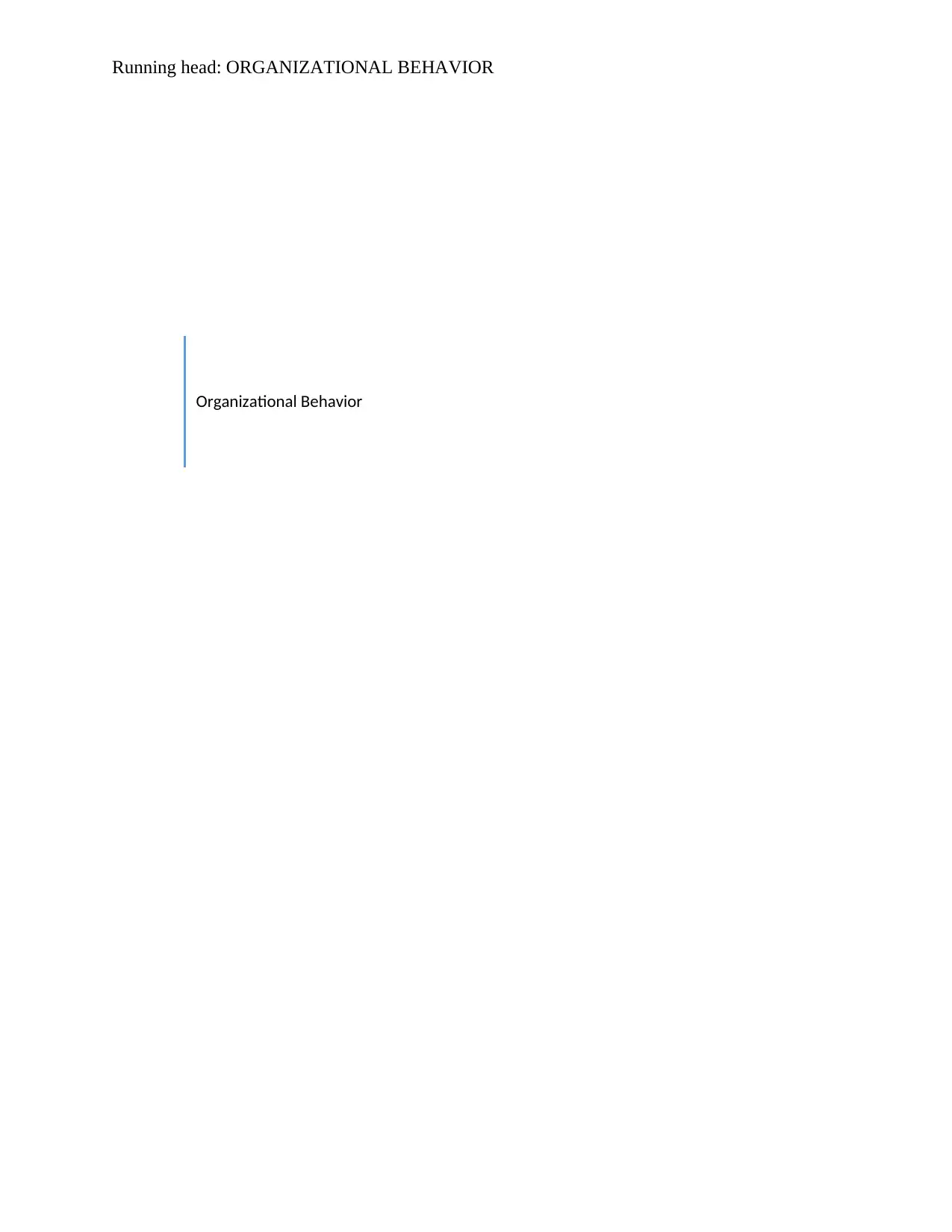
Running head: ORGANIZATIONAL BEHAVIOR
Organizational Behavior
Organizational Behavior
Paraphrase This Document
Need a fresh take? Get an instant paraphrase of this document with our AI Paraphraser
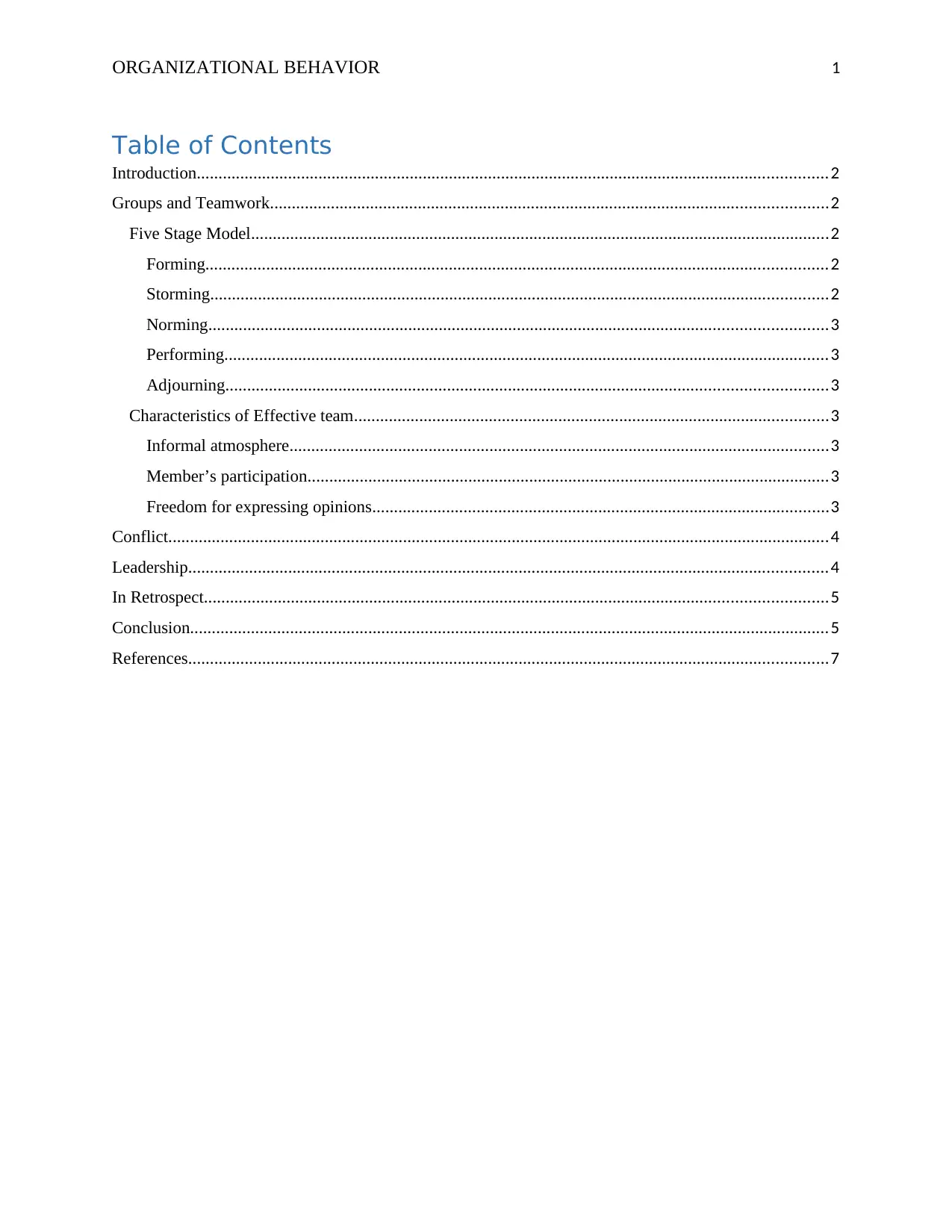
ORGANIZATIONAL BEHAVIOR 1
Table of Contents
Introduction.................................................................................................................................................2
Groups and Teamwork................................................................................................................................2
Five Stage Model.....................................................................................................................................2
Forming...............................................................................................................................................2
Storming..............................................................................................................................................2
Norming..............................................................................................................................................3
Performing...........................................................................................................................................3
Adjourning..........................................................................................................................................3
Characteristics of Effective team.............................................................................................................3
Informal atmosphere............................................................................................................................3
Member’s participation........................................................................................................................3
Freedom for expressing opinions.........................................................................................................3
Conflict........................................................................................................................................................4
Leadership...................................................................................................................................................4
In Retrospect...............................................................................................................................................5
Conclusion...................................................................................................................................................5
References...................................................................................................................................................7
Table of Contents
Introduction.................................................................................................................................................2
Groups and Teamwork................................................................................................................................2
Five Stage Model.....................................................................................................................................2
Forming...............................................................................................................................................2
Storming..............................................................................................................................................2
Norming..............................................................................................................................................3
Performing...........................................................................................................................................3
Adjourning..........................................................................................................................................3
Characteristics of Effective team.............................................................................................................3
Informal atmosphere............................................................................................................................3
Member’s participation........................................................................................................................3
Freedom for expressing opinions.........................................................................................................3
Conflict........................................................................................................................................................4
Leadership...................................................................................................................................................4
In Retrospect...............................................................................................................................................5
Conclusion...................................................................................................................................................5
References...................................................................................................................................................7
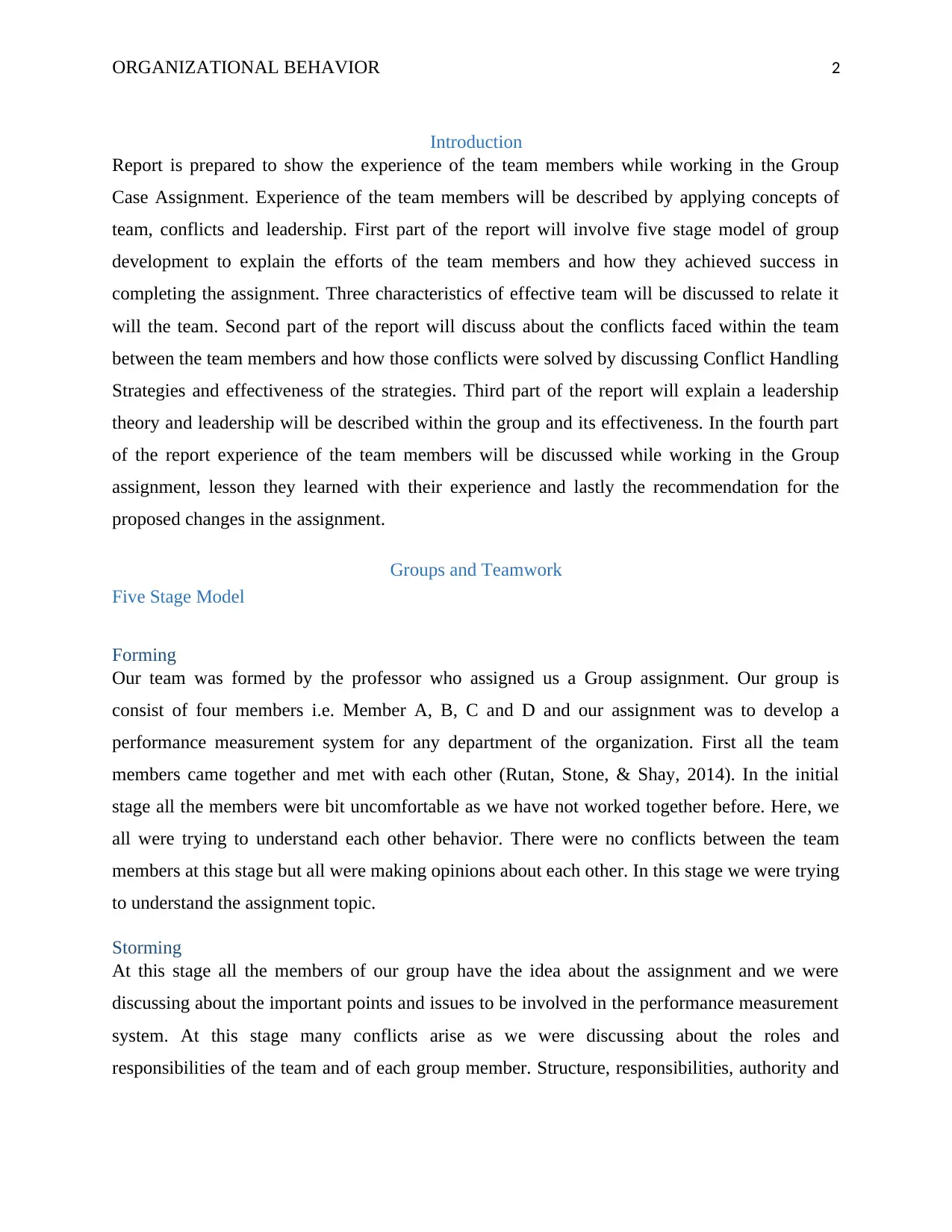
ORGANIZATIONAL BEHAVIOR 2
Introduction
Report is prepared to show the experience of the team members while working in the Group
Case Assignment. Experience of the team members will be described by applying concepts of
team, conflicts and leadership. First part of the report will involve five stage model of group
development to explain the efforts of the team members and how they achieved success in
completing the assignment. Three characteristics of effective team will be discussed to relate it
will the team. Second part of the report will discuss about the conflicts faced within the team
between the team members and how those conflicts were solved by discussing Conflict Handling
Strategies and effectiveness of the strategies. Third part of the report will explain a leadership
theory and leadership will be described within the group and its effectiveness. In the fourth part
of the report experience of the team members will be discussed while working in the Group
assignment, lesson they learned with their experience and lastly the recommendation for the
proposed changes in the assignment.
Groups and Teamwork
Five Stage Model
Forming
Our team was formed by the professor who assigned us a Group assignment. Our group is
consist of four members i.e. Member A, B, C and D and our assignment was to develop a
performance measurement system for any department of the organization. First all the team
members came together and met with each other (Rutan, Stone, & Shay, 2014). In the initial
stage all the members were bit uncomfortable as we have not worked together before. Here, we
all were trying to understand each other behavior. There were no conflicts between the team
members at this stage but all were making opinions about each other. In this stage we were trying
to understand the assignment topic.
Storming
At this stage all the members of our group have the idea about the assignment and we were
discussing about the important points and issues to be involved in the performance measurement
system. At this stage many conflicts arise as we were discussing about the roles and
responsibilities of the team and of each group member. Structure, responsibilities, authority and
Introduction
Report is prepared to show the experience of the team members while working in the Group
Case Assignment. Experience of the team members will be described by applying concepts of
team, conflicts and leadership. First part of the report will involve five stage model of group
development to explain the efforts of the team members and how they achieved success in
completing the assignment. Three characteristics of effective team will be discussed to relate it
will the team. Second part of the report will discuss about the conflicts faced within the team
between the team members and how those conflicts were solved by discussing Conflict Handling
Strategies and effectiveness of the strategies. Third part of the report will explain a leadership
theory and leadership will be described within the group and its effectiveness. In the fourth part
of the report experience of the team members will be discussed while working in the Group
assignment, lesson they learned with their experience and lastly the recommendation for the
proposed changes in the assignment.
Groups and Teamwork
Five Stage Model
Forming
Our team was formed by the professor who assigned us a Group assignment. Our group is
consist of four members i.e. Member A, B, C and D and our assignment was to develop a
performance measurement system for any department of the organization. First all the team
members came together and met with each other (Rutan, Stone, & Shay, 2014). In the initial
stage all the members were bit uncomfortable as we have not worked together before. Here, we
all were trying to understand each other behavior. There were no conflicts between the team
members at this stage but all were making opinions about each other. In this stage we were trying
to understand the assignment topic.
Storming
At this stage all the members of our group have the idea about the assignment and we were
discussing about the important points and issues to be involved in the performance measurement
system. At this stage many conflicts arise as we were discussing about the roles and
responsibilities of the team and of each group member. Structure, responsibilities, authority and
⊘ This is a preview!⊘
Do you want full access?
Subscribe today to unlock all pages.

Trusted by 1+ million students worldwide
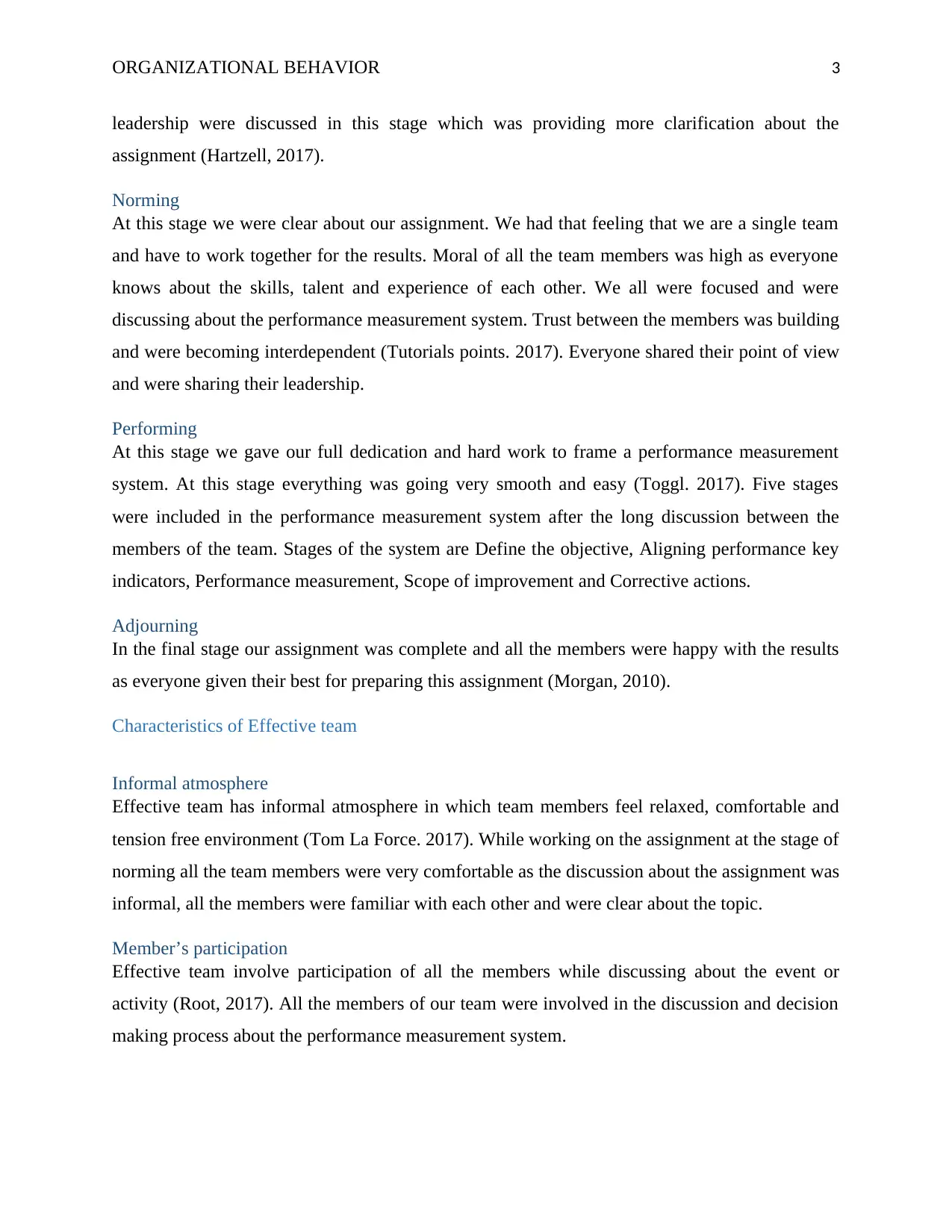
ORGANIZATIONAL BEHAVIOR 3
leadership were discussed in this stage which was providing more clarification about the
assignment (Hartzell, 2017).
Norming
At this stage we were clear about our assignment. We had that feeling that we are a single team
and have to work together for the results. Moral of all the team members was high as everyone
knows about the skills, talent and experience of each other. We all were focused and were
discussing about the performance measurement system. Trust between the members was building
and were becoming interdependent (Tutorials points. 2017). Everyone shared their point of view
and were sharing their leadership.
Performing
At this stage we gave our full dedication and hard work to frame a performance measurement
system. At this stage everything was going very smooth and easy (Toggl. 2017). Five stages
were included in the performance measurement system after the long discussion between the
members of the team. Stages of the system are Define the objective, Aligning performance key
indicators, Performance measurement, Scope of improvement and Corrective actions.
Adjourning
In the final stage our assignment was complete and all the members were happy with the results
as everyone given their best for preparing this assignment (Morgan, 2010).
Characteristics of Effective team
Informal atmosphere
Effective team has informal atmosphere in which team members feel relaxed, comfortable and
tension free environment (Tom La Force. 2017). While working on the assignment at the stage of
norming all the team members were very comfortable as the discussion about the assignment was
informal, all the members were familiar with each other and were clear about the topic.
Member’s participation
Effective team involve participation of all the members while discussing about the event or
activity (Root, 2017). All the members of our team were involved in the discussion and decision
making process about the performance measurement system.
leadership were discussed in this stage which was providing more clarification about the
assignment (Hartzell, 2017).
Norming
At this stage we were clear about our assignment. We had that feeling that we are a single team
and have to work together for the results. Moral of all the team members was high as everyone
knows about the skills, talent and experience of each other. We all were focused and were
discussing about the performance measurement system. Trust between the members was building
and were becoming interdependent (Tutorials points. 2017). Everyone shared their point of view
and were sharing their leadership.
Performing
At this stage we gave our full dedication and hard work to frame a performance measurement
system. At this stage everything was going very smooth and easy (Toggl. 2017). Five stages
were included in the performance measurement system after the long discussion between the
members of the team. Stages of the system are Define the objective, Aligning performance key
indicators, Performance measurement, Scope of improvement and Corrective actions.
Adjourning
In the final stage our assignment was complete and all the members were happy with the results
as everyone given their best for preparing this assignment (Morgan, 2010).
Characteristics of Effective team
Informal atmosphere
Effective team has informal atmosphere in which team members feel relaxed, comfortable and
tension free environment (Tom La Force. 2017). While working on the assignment at the stage of
norming all the team members were very comfortable as the discussion about the assignment was
informal, all the members were familiar with each other and were clear about the topic.
Member’s participation
Effective team involve participation of all the members while discussing about the event or
activity (Root, 2017). All the members of our team were involved in the discussion and decision
making process about the performance measurement system.
Paraphrase This Document
Need a fresh take? Get an instant paraphrase of this document with our AI Paraphraser
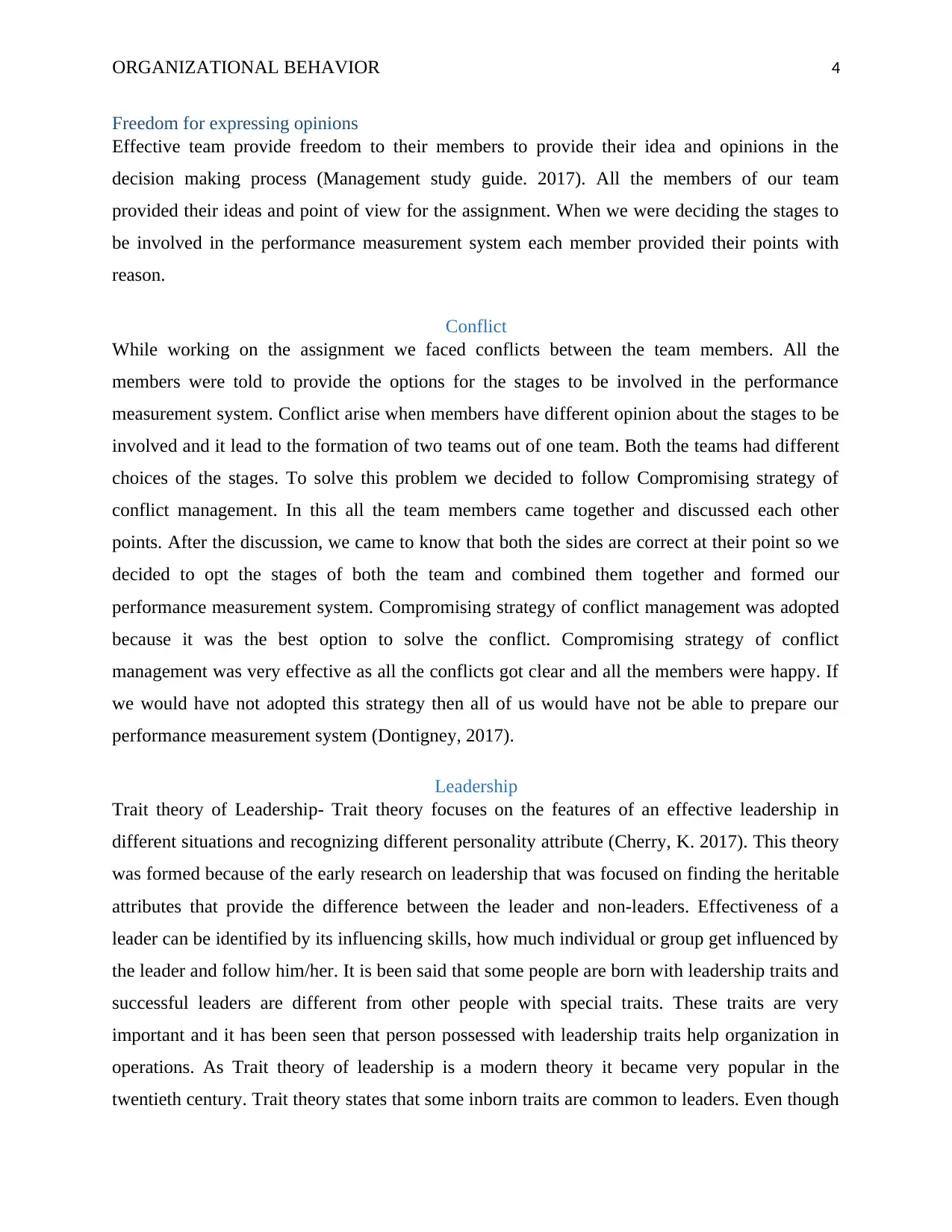
ORGANIZATIONAL BEHAVIOR 4
Freedom for expressing opinions
Effective team provide freedom to their members to provide their idea and opinions in the
decision making process (Management study guide. 2017). All the members of our team
provided their ideas and point of view for the assignment. When we were deciding the stages to
be involved in the performance measurement system each member provided their points with
reason.
Conflict
While working on the assignment we faced conflicts between the team members. All the
members were told to provide the options for the stages to be involved in the performance
measurement system. Conflict arise when members have different opinion about the stages to be
involved and it lead to the formation of two teams out of one team. Both the teams had different
choices of the stages. To solve this problem we decided to follow Compromising strategy of
conflict management. In this all the team members came together and discussed each other
points. After the discussion, we came to know that both the sides are correct at their point so we
decided to opt the stages of both the team and combined them together and formed our
performance measurement system. Compromising strategy of conflict management was adopted
because it was the best option to solve the conflict. Compromising strategy of conflict
management was very effective as all the conflicts got clear and all the members were happy. If
we would have not adopted this strategy then all of us would have not be able to prepare our
performance measurement system (Dontigney, 2017).
Leadership
Trait theory of Leadership- Trait theory focuses on the features of an effective leadership in
different situations and recognizing different personality attribute (Cherry, K. 2017). This theory
was formed because of the early research on leadership that was focused on finding the heritable
attributes that provide the difference between the leader and non-leaders. Effectiveness of a
leader can be identified by its influencing skills, how much individual or group get influenced by
the leader and follow him/her. It is been said that some people are born with leadership traits and
successful leaders are different from other people with special traits. These traits are very
important and it has been seen that person possessed with leadership traits help organization in
operations. As Trait theory of leadership is a modern theory it became very popular in the
twentieth century. Trait theory states that some inborn traits are common to leaders. Even though
Freedom for expressing opinions
Effective team provide freedom to their members to provide their idea and opinions in the
decision making process (Management study guide. 2017). All the members of our team
provided their ideas and point of view for the assignment. When we were deciding the stages to
be involved in the performance measurement system each member provided their points with
reason.
Conflict
While working on the assignment we faced conflicts between the team members. All the
members were told to provide the options for the stages to be involved in the performance
measurement system. Conflict arise when members have different opinion about the stages to be
involved and it lead to the formation of two teams out of one team. Both the teams had different
choices of the stages. To solve this problem we decided to follow Compromising strategy of
conflict management. In this all the team members came together and discussed each other
points. After the discussion, we came to know that both the sides are correct at their point so we
decided to opt the stages of both the team and combined them together and formed our
performance measurement system. Compromising strategy of conflict management was adopted
because it was the best option to solve the conflict. Compromising strategy of conflict
management was very effective as all the conflicts got clear and all the members were happy. If
we would have not adopted this strategy then all of us would have not be able to prepare our
performance measurement system (Dontigney, 2017).
Leadership
Trait theory of Leadership- Trait theory focuses on the features of an effective leadership in
different situations and recognizing different personality attribute (Cherry, K. 2017). This theory
was formed because of the early research on leadership that was focused on finding the heritable
attributes that provide the difference between the leader and non-leaders. Effectiveness of a
leader can be identified by its influencing skills, how much individual or group get influenced by
the leader and follow him/her. It is been said that some people are born with leadership traits and
successful leaders are different from other people with special traits. These traits are very
important and it has been seen that person possessed with leadership traits help organization in
operations. As Trait theory of leadership is a modern theory it became very popular in the
twentieth century. Trait theory states that some inborn traits are common to leaders. Even though
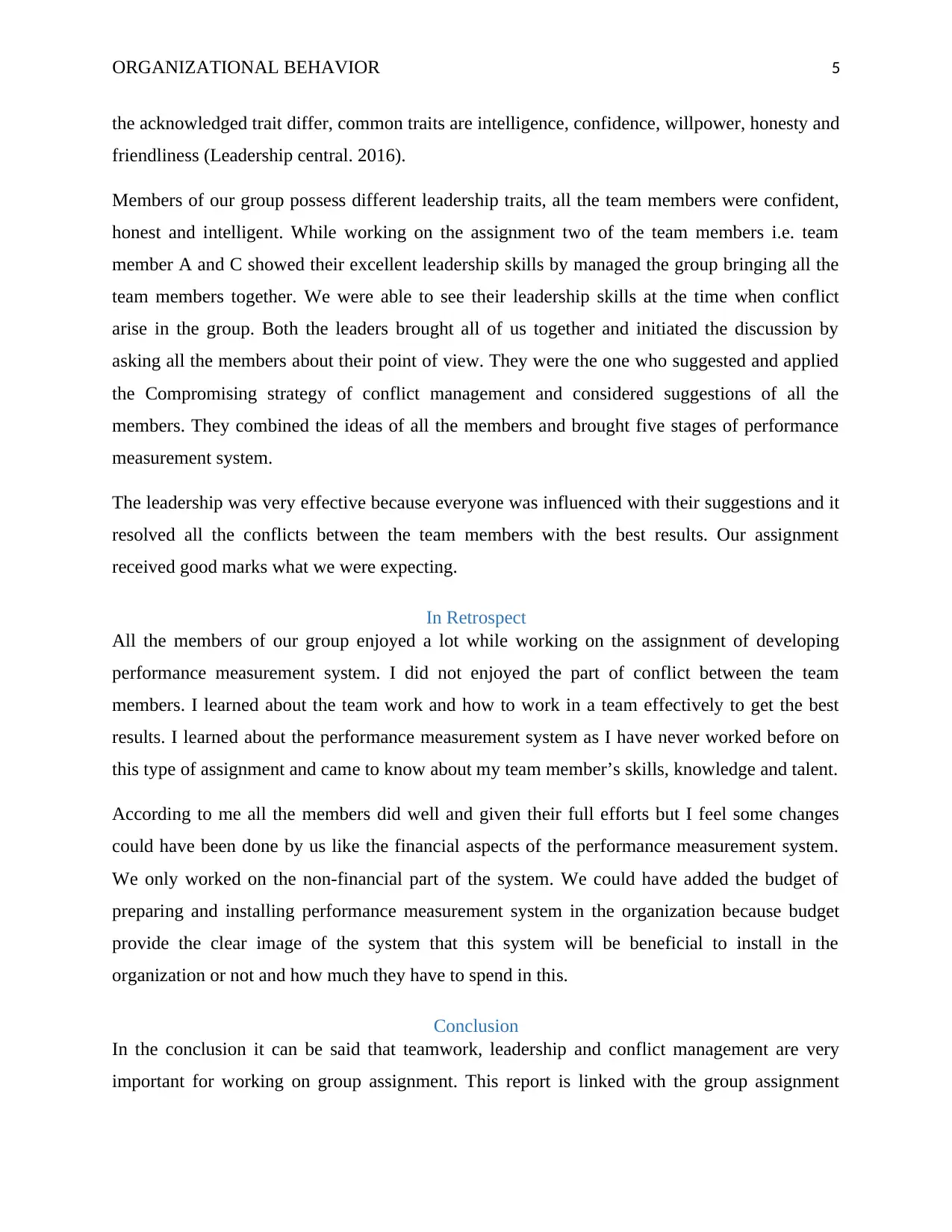
ORGANIZATIONAL BEHAVIOR 5
the acknowledged trait differ, common traits are intelligence, confidence, willpower, honesty and
friendliness (Leadership central. 2016).
Members of our group possess different leadership traits, all the team members were confident,
honest and intelligent. While working on the assignment two of the team members i.e. team
member A and C showed their excellent leadership skills by managed the group bringing all the
team members together. We were able to see their leadership skills at the time when conflict
arise in the group. Both the leaders brought all of us together and initiated the discussion by
asking all the members about their point of view. They were the one who suggested and applied
the Compromising strategy of conflict management and considered suggestions of all the
members. They combined the ideas of all the members and brought five stages of performance
measurement system.
The leadership was very effective because everyone was influenced with their suggestions and it
resolved all the conflicts between the team members with the best results. Our assignment
received good marks what we were expecting.
In Retrospect
All the members of our group enjoyed a lot while working on the assignment of developing
performance measurement system. I did not enjoyed the part of conflict between the team
members. I learned about the team work and how to work in a team effectively to get the best
results. I learned about the performance measurement system as I have never worked before on
this type of assignment and came to know about my team member’s skills, knowledge and talent.
According to me all the members did well and given their full efforts but I feel some changes
could have been done by us like the financial aspects of the performance measurement system.
We only worked on the non-financial part of the system. We could have added the budget of
preparing and installing performance measurement system in the organization because budget
provide the clear image of the system that this system will be beneficial to install in the
organization or not and how much they have to spend in this.
Conclusion
In the conclusion it can be said that teamwork, leadership and conflict management are very
important for working on group assignment. This report is linked with the group assignment
the acknowledged trait differ, common traits are intelligence, confidence, willpower, honesty and
friendliness (Leadership central. 2016).
Members of our group possess different leadership traits, all the team members were confident,
honest and intelligent. While working on the assignment two of the team members i.e. team
member A and C showed their excellent leadership skills by managed the group bringing all the
team members together. We were able to see their leadership skills at the time when conflict
arise in the group. Both the leaders brought all of us together and initiated the discussion by
asking all the members about their point of view. They were the one who suggested and applied
the Compromising strategy of conflict management and considered suggestions of all the
members. They combined the ideas of all the members and brought five stages of performance
measurement system.
The leadership was very effective because everyone was influenced with their suggestions and it
resolved all the conflicts between the team members with the best results. Our assignment
received good marks what we were expecting.
In Retrospect
All the members of our group enjoyed a lot while working on the assignment of developing
performance measurement system. I did not enjoyed the part of conflict between the team
members. I learned about the team work and how to work in a team effectively to get the best
results. I learned about the performance measurement system as I have never worked before on
this type of assignment and came to know about my team member’s skills, knowledge and talent.
According to me all the members did well and given their full efforts but I feel some changes
could have been done by us like the financial aspects of the performance measurement system.
We only worked on the non-financial part of the system. We could have added the budget of
preparing and installing performance measurement system in the organization because budget
provide the clear image of the system that this system will be beneficial to install in the
organization or not and how much they have to spend in this.
Conclusion
In the conclusion it can be said that teamwork, leadership and conflict management are very
important for working on group assignment. This report is linked with the group assignment
⊘ This is a preview!⊘
Do you want full access?
Subscribe today to unlock all pages.

Trusted by 1+ million students worldwide
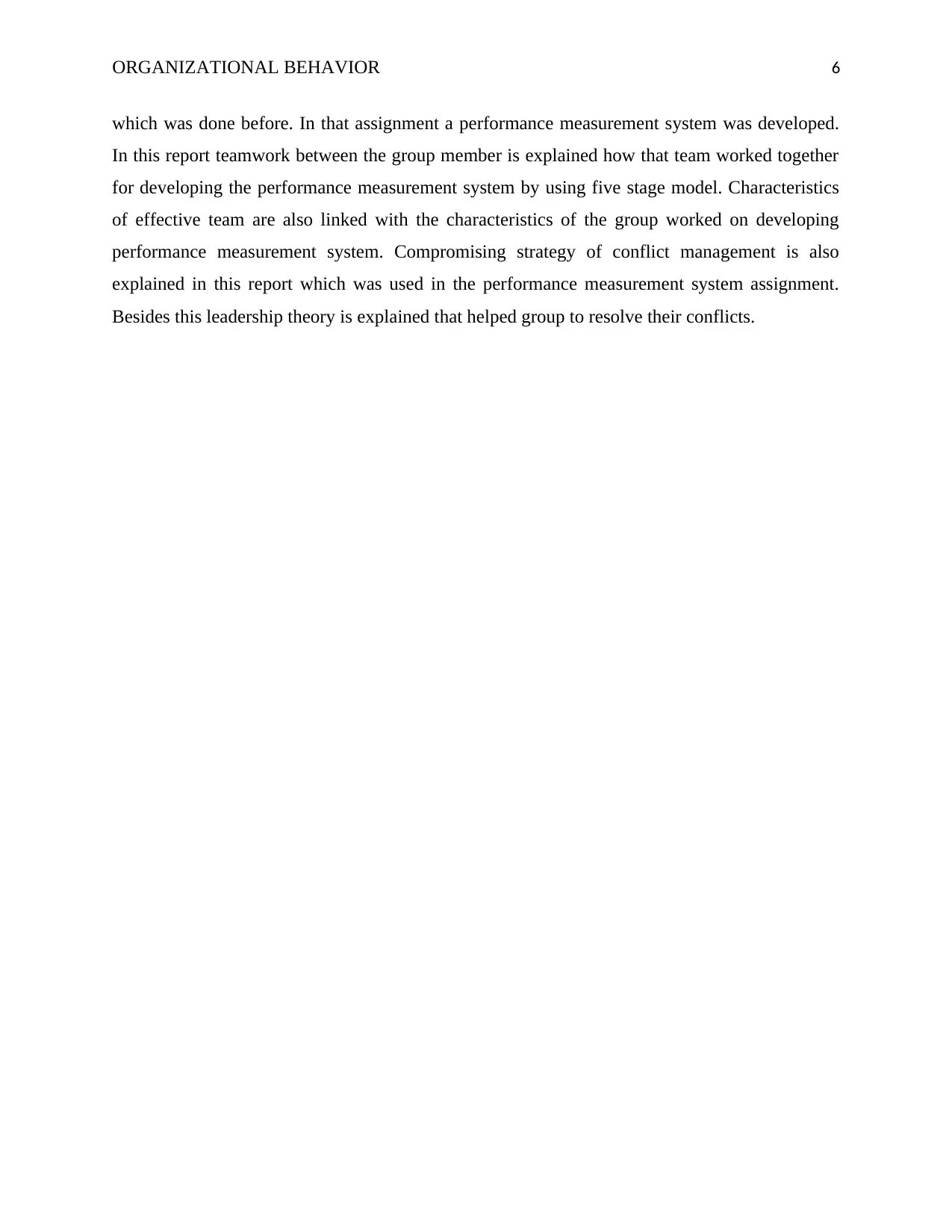
ORGANIZATIONAL BEHAVIOR 6
which was done before. In that assignment a performance measurement system was developed.
In this report teamwork between the group member is explained how that team worked together
for developing the performance measurement system by using five stage model. Characteristics
of effective team are also linked with the characteristics of the group worked on developing
performance measurement system. Compromising strategy of conflict management is also
explained in this report which was used in the performance measurement system assignment.
Besides this leadership theory is explained that helped group to resolve their conflicts.
which was done before. In that assignment a performance measurement system was developed.
In this report teamwork between the group member is explained how that team worked together
for developing the performance measurement system by using five stage model. Characteristics
of effective team are also linked with the characteristics of the group worked on developing
performance measurement system. Compromising strategy of conflict management is also
explained in this report which was used in the performance measurement system assignment.
Besides this leadership theory is explained that helped group to resolve their conflicts.
Paraphrase This Document
Need a fresh take? Get an instant paraphrase of this document with our AI Paraphraser
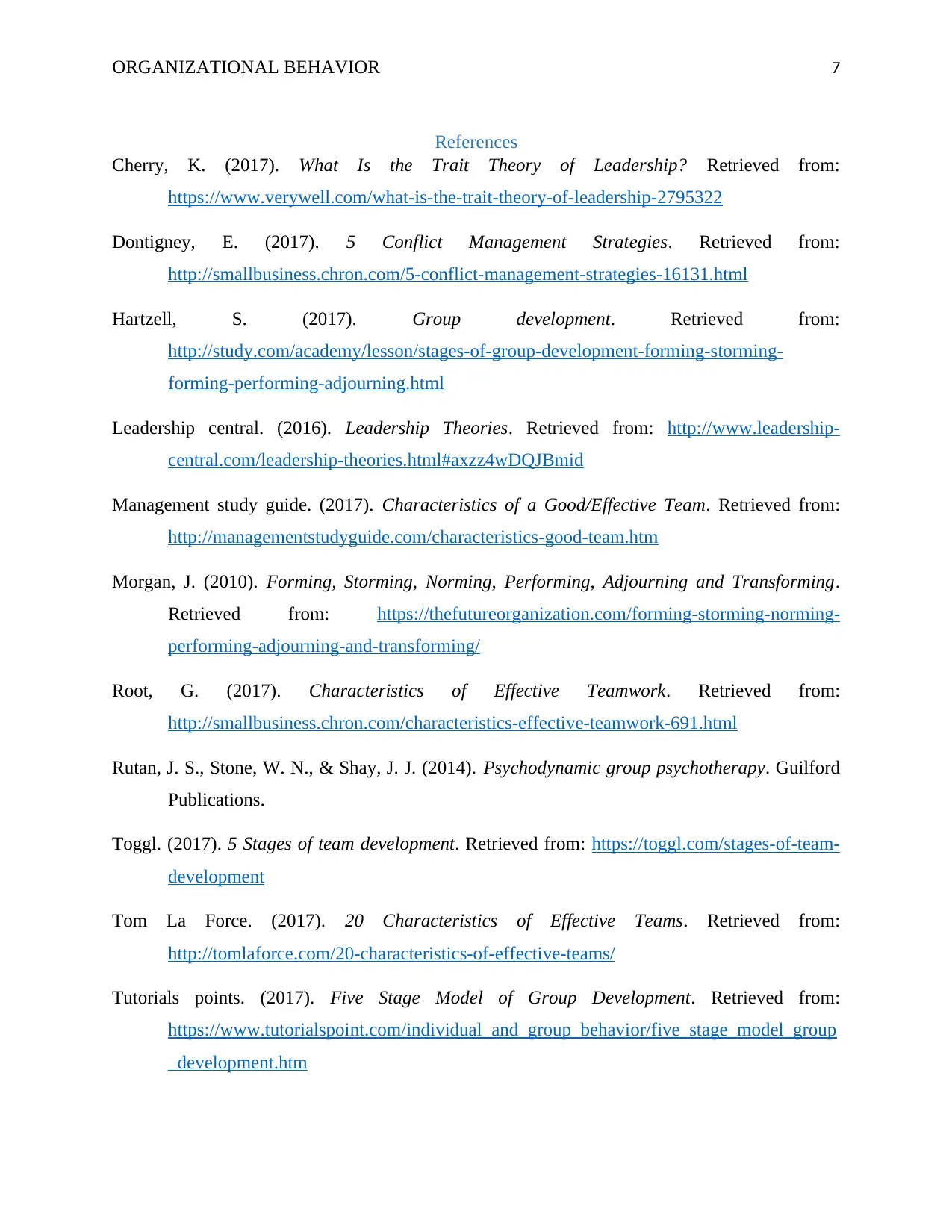
ORGANIZATIONAL BEHAVIOR 7
References
Cherry, K. (2017). What Is the Trait Theory of Leadership? Retrieved from:
https://www.verywell.com/what-is-the-trait-theory-of-leadership-2795322
Dontigney, E. (2017). 5 Conflict Management Strategies. Retrieved from:
http://smallbusiness.chron.com/5-conflict-management-strategies-16131.html
Hartzell, S. (2017). Group development. Retrieved from:
http://study.com/academy/lesson/stages-of-group-development-forming-storming-
forming-performing-adjourning.html
Leadership central. (2016). Leadership Theories. Retrieved from: http://www.leadership-
central.com/leadership-theories.html#axzz4wDQJBmid
Management study guide. (2017). Characteristics of a Good/Effective Team. Retrieved from:
http://managementstudyguide.com/characteristics-good-team.htm
Morgan, J. (2010). Forming, Storming, Norming, Performing, Adjourning and Transforming.
Retrieved from: https://thefutureorganization.com/forming-storming-norming-
performing-adjourning-and-transforming/
Root, G. (2017). Characteristics of Effective Teamwork. Retrieved from:
http://smallbusiness.chron.com/characteristics-effective-teamwork-691.html
Rutan, J. S., Stone, W. N., & Shay, J. J. (2014). Psychodynamic group psychotherapy. Guilford
Publications.
Toggl. (2017). 5 Stages of team development. Retrieved from: https://toggl.com/stages-of-team-
development
Tom La Force. (2017). 20 Characteristics of Effective Teams. Retrieved from:
http://tomlaforce.com/20-characteristics-of-effective-teams/
Tutorials points. (2017). Five Stage Model of Group Development. Retrieved from:
https://www.tutorialspoint.com/individual_and_group_behavior/five_stage_model_group
_development.htm
References
Cherry, K. (2017). What Is the Trait Theory of Leadership? Retrieved from:
https://www.verywell.com/what-is-the-trait-theory-of-leadership-2795322
Dontigney, E. (2017). 5 Conflict Management Strategies. Retrieved from:
http://smallbusiness.chron.com/5-conflict-management-strategies-16131.html
Hartzell, S. (2017). Group development. Retrieved from:
http://study.com/academy/lesson/stages-of-group-development-forming-storming-
forming-performing-adjourning.html
Leadership central. (2016). Leadership Theories. Retrieved from: http://www.leadership-
central.com/leadership-theories.html#axzz4wDQJBmid
Management study guide. (2017). Characteristics of a Good/Effective Team. Retrieved from:
http://managementstudyguide.com/characteristics-good-team.htm
Morgan, J. (2010). Forming, Storming, Norming, Performing, Adjourning and Transforming.
Retrieved from: https://thefutureorganization.com/forming-storming-norming-
performing-adjourning-and-transforming/
Root, G. (2017). Characteristics of Effective Teamwork. Retrieved from:
http://smallbusiness.chron.com/characteristics-effective-teamwork-691.html
Rutan, J. S., Stone, W. N., & Shay, J. J. (2014). Psychodynamic group psychotherapy. Guilford
Publications.
Toggl. (2017). 5 Stages of team development. Retrieved from: https://toggl.com/stages-of-team-
development
Tom La Force. (2017). 20 Characteristics of Effective Teams. Retrieved from:
http://tomlaforce.com/20-characteristics-of-effective-teams/
Tutorials points. (2017). Five Stage Model of Group Development. Retrieved from:
https://www.tutorialspoint.com/individual_and_group_behavior/five_stage_model_group
_development.htm

ORGANIZATIONAL BEHAVIOR 8
⊘ This is a preview!⊘
Do you want full access?
Subscribe today to unlock all pages.

Trusted by 1+ million students worldwide
1 out of 9
Related Documents
Your All-in-One AI-Powered Toolkit for Academic Success.
+13062052269
info@desklib.com
Available 24*7 on WhatsApp / Email
![[object Object]](/_next/static/media/star-bottom.7253800d.svg)
Unlock your academic potential
Copyright © 2020–2025 A2Z Services. All Rights Reserved. Developed and managed by ZUCOL.




